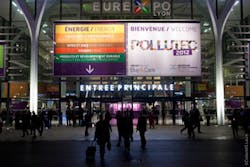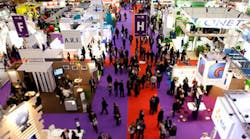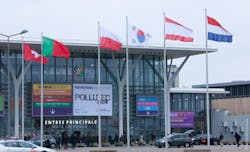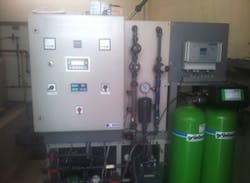The site needs to receive an authorization from the local authorities. This certificate is usually obtained after hiring a consulting firm that produces a report which is then examined and approved (or not) by the local environmental and health authorities.
This process is costly and requires sites like the St Maur water treatment plant to follow a stringent protocol for the handling and storage of chlorine.
The solution
The OSEC-B systems produce sodium hypochlorite on demand by combining a salt solution and electricity inside a cell of electrodes. This is where the brine is electrolyzed into sodium hypochlorite (NaOCl).
Since the OSEC-B system produces <1.0 wt% solution of sodium hypochlorite on demand, there is no major storage facility needed, no need for handling dangerous chemicals and it does not create inconvenient protocols for delivery of hazardous materials. The only material that needs to be delivered is salt.
In terms of daily operations, the operator just needs to keep an eye on the salt levels and make sure they do not fall too low. The Saint Maur plant has a 15 cubic meter silo, which is refilled with salt by a truck two to three times yearly. The annual average salt consumption is approximately 25 metric tons.
Once the salt is in the silo, the whole process is automated. The OSEC-B system produces sodium hypochlorite which is pumped to a storage tank. When the tank is full, the unit stops and when the tank level is low the unit automatically starts producing again.
Saint Maur water treatment plant produced more than five million cubic meters of water disinfected by the OSEC-B system in 2013.
The result
Madame Heuillard, head of production and quality at St Maur, said: "Yes, the OSEC-B electrolyzer was initially installed to reduce the risk and help with the plant's ICPE classification. But really we ended up getting a lot more out of it. The supply of salt is much more flexible than chlorine, and the ease of operation is optimal. It just runs on its own once the salt is supplied. There is no risk of chlorine gas leaks, and the hydrogen detection system has never gone off in over 20 years of operation. The operating costs have been reduced because the salt is inexpensive, and the maintenance costs are very low."
In fact, the first significant maintenance on the OSEC-B system was performed in 2013, 20 years after the unit was first installed. The electrode cell was cleaned with an acid solution and was put right back into service.
Today, the OSEC-B electrolyzer is still running, 21 years after it was first installed. Since then, the only major component that has been replaced is the water softener. The Saint Maur water treatment plant concerns over the ICPE classification were solved with the application of on-site chlorination. The benefit of having very low operating costs and the ease of operation and maintenance were an added plus.
www.evoqua.com
More Water & WasteWater International Current Issue Articles
More Water & WasteWater International Archives Issue Articles





